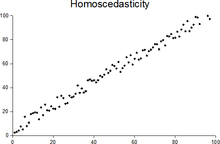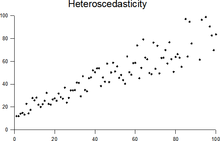438:, weather datasets are acquired over many years of record and, as part of this, measurements at certain stations may cease occasionally while, at around the same time, measurements may start at nearby locations. There are then questions as to whether, if the records are combined to form a single longer set of records, those records can be considered homogeneous over time. An example of homogeneity testing of wind speed and direction data can be found in Romanić
426:, data-series across a number of sites composed of annual values of the within-year annual maximum river-flow are analysed. A common model is that the distributions of these values are the same for all sites apart from a simple scaling factor, so that the location and scale are linked in a simple way. There can then be questions of examining the homogeneity across sites of the distribution of the scaled values.
134:
114:
400:
Differences in the typical values across the dataset might initially be dealt with by constructing a regression model using certain explanatory variables to relate variations in the typical value to known quantities. There should then be a later stage of analysis to examine whether the errors in the
95:
The concept of homogeneity can be applied in many different ways and, for certain types of statistical analysis, it is used to look for further properties that might need to be treated as varying within a dataset once some initial types of non-homogeneity have been dealt with.
450:
Simple populations surveys may start from the idea that responses will be homogeneous across the whole of a population. Assessing the homogeneity of the population would involve looking to see whether the responses of certain identifiable
413:
The initial stages in the analysis of a time series may involve plotting values against time to examine homogeneity of the series in various ways: stability across time as opposed to a trend; stability of local fluctuations over time.
401:
predictions from the regression behave in the same way across the dataset. Thus the question becomes one of the homogeneity of the distribution of the residuals, as the explanatory variables change. See
53:, or several datasets. They relate to the validity of the often convenient assumption that the statistical properties of any one part of an overall dataset are the same as any other part. In
772:
Romanić D. Ćurić M- Jovičić I. Lompar M. 2015. Long-term trends of the ‘Koshava’ wind during the period 1949–2010. International
Journal of Climatology 35(2):288-302. DOI:10.1002/joc.3981.
233:
are also frequently used. “Skedasticity” comes from the
Ancient Greek word “skedánnymi”, meaning “to scatter”. Assuming a variable is homoscedastic when in reality it is heteroscedastic (
338:
estimator is still unbiased in the presence of heteroscedasticity, it is inefficient and inference based on the assumption of homoskedasticity is misleading. In that case,
312:
383:
343:
225:; this is also known as homogeneity of variance. The complementary notion is called heteroscedasticity, also known as heterogeneity of variance. The spellings
162:
106:
806:
455:
differ from those of others. For example, car-owners may differ from non-car-owners, or there may be differences between different age-groups.
714:
686:
57:, which combines the data from several studies, homogeneity measures the differences or similarities between the several studies (see also
730:
Engle, Robert F. (July 1982). "Autoregressive
Conditional Heteroscedasticity with Estimates of the Variance of United Kingdom Inflation".
705:; Trivedi, Pravin K. (1993). "Some Specification Tests for the Linear Regression Model". In Bollen, Kenneth A.; Long, J. Scott (eds.).
375:
331:
633:
597:
539:
White, Halbert (1980). "A heteroskedasticity-consistent covariance matrix estimator and a direct test for heteroskedasticity".
362:
649:
327:
828:
31:
811:
Loevinger, J. (1948). The technic of homogeneous tests compared with some aspects of scale analysis and factor analysis.
801:
Krus, D.J., & Blackman, H.S. (1988).Test reliability and homogeneity from perspective of the ordinal test theory.
787:
339:
489:
484:
73:
297:
463:
A test for homogeneity, in the sense of exact equivalence of statistical distributions, can be based on an
72:
of data-values changes throughout a dataset. However, questions of homogeneity apply to all aspects of the
833:
548:
335:
81:
785:
Hall, M.J. (2003) The interpretation of non-homogeneous hydrometeorological time series a case study.
358:
323:
668:
84:. An intermediate-level study might move from looking at the variability to studying changes in the
553:
402:
379:
319:
89:
58:
755:
566:
521:
472:
347:
342:(GLS) was frequently used in the past. Nowadays, standard practice in econometrics is to include
77:
625:
747:
710:
682:
629:
613:
593:
792:
739:
674:
558:
293:
236:
168:
65:
64:
Homogeneity can be studied to several degrees of complexity. For example, considerations of
308:
158:
17:
618:
585:
368:
354:
304:
300:
822:
702:
468:
452:
54:
346:
instead of using GLS, as GLS can exhibit strong bias in small samples if the actual
512:
371:
133:
464:
435:
113:
796:
150:
38:
751:
423:
382:
in the presence of heteroscedasticity, which led to his formulation of the
678:
222:
154:
126:
85:
69:
80:. Thus, a more detailed study would examine changes to the whole of the
759:
570:
525:
50:
137:
Plot with random data showing heteroscedasticity: The variance of the
743:
562:
88:. In addition to these, questions of homogeneity apply also to the
132:
112:
117:
Plot with random data showing homoscedasticity: at each value of
471:
tests the simpler hypothesis that distributions have the same
251:
318:
The existence of heteroscedasticity is a major concern in
263:
254:
245:
192:
183:
177:
592:(Fifth ed.). Boston: McGraw-Hill Irwin. p. 400.
281:
272:
210:
201:
667:
Angrist, Joshua D.; Pischke, Jörn-Steffen (2009-12-31).
141:-values of the dots increases with increasing values of
670:
Mostly
Harmless Econometrics: An Empiricist's Companion
510:
McCulloch, J. Huston (1985). "On
Heteros*edasticity".
284:
275:
260:
257:
239:
213:
204:
189:
186:
171:
278:
269:
248:
207:
198:
266:
242:
221:) if all its random variables have the same finite
195:
180:
174:
617:
361:of the errors, its presence is referred to as
384:autoregressive conditional heteroscedasticity
344:Heteroskedasticity-consistent standard errors
8:
624:. New York: John Wiley & Sons. pp.
656:. New York: McGraw-Hill. pp. 214–221.
49:, arise in describing the properties of a
552:
508:For the Greek etymology of the term, see
30:For broader coverage of this topic, see
501:
307:, and may result in overestimating the
107:Homoscedasticity and heteroscedasticity
334:all have the same variance. While the
125:-value of the dots has about the same
27:Descriptions of properties of datasets
7:
353:Because heteroscedasticity concerns
707:Testing Structural Equation Models
418:Combining information across sites
376:Nobel Memorial Prize for Economics
25:
803:Applied Measurement in Education,
709:. London: Sage. pp. 66–110.
328:statistical tests of significance
235:
167:
105:This section is an excerpt from
673:. Princeton University Press.
446:Homogeneity within populations
1:
430:Combining information sources
32:Homogeneity and heterogeneity
788:Meteorological Applications
303:and in biased estimates of
850:
386:(ARCH) modeling technique.
104:
29:
797:10.1017/S1350482703005061
340:generalized least squares
74:statistical distributions
490:Reliability (statistics)
485:Consistency (statistics)
18:Homogeneity (statistics)
813:Psychological Bulletin,
336:ordinary least squares
146:
130:
679:10.1515/9781400829828
614:Goldberger, Arthur S.
374:was awarded the 2003
365:of the second order.
330:that assume that the
136:
116:
82:marginal distribution
68:examine how much the
829:Statistical analysis
326:, as it invalidates
324:analysis of variance
791:, 10, 61–67.
654:Econometric Methods
403:regression analysis
380:regression analysis
378:for his studies on
320:regression analysis
313:Pearson coefficient
311:as measured by the
90:joint distributions
59:Study heterogeneity
815:45, 507–529.
807:(Request reprint).
620:Econometric Theory
590:Basic Econometrics
473:location parameter
348:skedastic function
231:heteroskedasticity
147:
131:
78:location parameter
45:and its opposite,
716:978-0-8039-4506-7
688:978-1-4008-2982-8
584:Gujarati, D. N.;
16:(Redirected from
841:
773:
770:
764:
763:
727:
721:
720:
699:
693:
692:
664:
658:
657:
646:
640:
639:
623:
610:
604:
603:
581:
575:
574:
556:
536:
530:
529:
506:
363:misspecification
332:modelling errors
291:
290:
287:
286:
283:
280:
277:
274:
271:
268:
265:
262:
259:
256:
253:
250:
247:
244:
241:
227:homoskedasticity
220:
219:
216:
215:
212:
209:
206:
203:
200:
197:
194:
191:
188:
185:
182:
179:
176:
173:
159:random variables
76:, including the
66:homoscedasticity
21:
849:
848:
844:
843:
842:
840:
839:
838:
819:
818:
805:1, 79–88
782:
780:Further reading
777:
776:
771:
767:
744:10.2307/1912773
738:(4): 987–1007.
729:
728:
724:
717:
701:
700:
696:
689:
666:
665:
661:
648:
647:
643:
636:
612:
611:
607:
600:
583:
582:
578:
563:10.2307/1912934
538:
537:
533:
509:
507:
503:
498:
481:
461:
448:
432:
420:
411:
398:
393:
388:
387:
309:goodness of fit
305:standard errors
301:point estimates
238:
234:
170:
166:
110:
102:
35:
28:
23:
22:
15:
12:
11:
5:
847:
845:
837:
836:
831:
821:
820:
817:
816:
809:
799:
781:
778:
775:
774:
765:
722:
715:
703:Long, J. Scott
694:
687:
659:
641:
634:
605:
598:
576:
554:10.1.1.11.7646
547:(4): 817–838.
531:
500:
499:
497:
494:
493:
492:
487:
480:
477:
460:
457:
453:subpopulations
447:
444:
431:
428:
419:
416:
410:
407:
397:
394:
392:
389:
369:econometrician
357:of the second
111:
103:
101:
98:
26:
24:
14:
13:
10:
9:
6:
4:
3:
2:
846:
835:
834:Meta-analysis
832:
830:
827:
826:
824:
814:
810:
808:
804:
800:
798:
794:
790:
789:
784:
783:
779:
769:
766:
761:
757:
753:
749:
745:
741:
737:
733:
726:
723:
718:
712:
708:
704:
698:
695:
690:
684:
680:
676:
672:
671:
663:
660:
655:
651:
645:
642:
637:
635:9780471311010
631:
627:
622:
621:
615:
609:
606:
601:
599:9780073375779
595:
591:
587:
586:Porter, D. C.
580:
577:
572:
568:
564:
560:
555:
550:
546:
542:
535:
532:
527:
523:
519:
515:
514:
505:
502:
495:
491:
488:
486:
483:
482:
478:
476:
474:
470:
469:location test
466:
458:
456:
454:
445:
443:
441:
437:
429:
427:
425:
417:
415:
408:
406:
404:
395:
390:
385:
381:
377:
373:
370:
366:
364:
360:
356:
351:
349:
345:
341:
337:
333:
329:
325:
321:
316:
314:
310:
306:
302:
299:
295:
292:) results in
289:
232:
228:
224:
218:
164:
163:homoscedastic
160:
156:
152:
144:
140:
135:
128:
124:
120:
115:
108:
99:
97:
93:
91:
87:
83:
79:
75:
71:
67:
62:
60:
56:
55:meta-analysis
52:
48:
47:heterogeneity
44:
40:
33:
19:
812:
802:
786:
768:
735:
732:Econometrica
731:
725:
706:
697:
669:
662:
653:
650:Johnston, J.
644:
619:
608:
589:
579:
544:
541:Econometrica
540:
534:
517:
513:Econometrica
511:
504:
462:
449:
439:
433:
421:
412:
399:
372:Robert Engle
355:expectations
352:
350:is unknown.
317:
230:
226:
148:
142:
138:
122:
118:
94:
63:
46:
42:
36:
465:E-statistic
436:meteorology
409:Time series
298:inefficient
100:Of variance
70:variability
43:homogeneity
823:Categories
520:(2): 483.
496:References
396:Regression
151:statistics
39:statistics
752:0012-9682
549:CiteSeerX
442:., 2015.
424:hydrology
652:(1972).
616:(1964).
588:(2009).
479:See also
391:Examples
322:and the
294:unbiased
223:variance
155:sequence
127:variance
86:skewness
760:1912773
626:238–243
571:1912934
526:1911250
51:dataset
758:
750:
713:
685:
632:
596:
569:
551:
524:
359:moment
121:, the
756:JSTOR
567:JSTOR
522:JSTOR
459:Tests
440:et al
748:ISSN
711:ISBN
683:ISBN
630:ISBN
594:ISBN
467:. A
367:The
296:but
229:and
153:, a
793:doi
740:doi
675:doi
559:doi
434:In
422:In
161:is
157:of
149:In
61:).
37:In
825::
754:.
746:.
736:50
734:.
681:.
628:.
565:.
557:.
545:48
543:.
518:53
516:.
475:.
405:.
315:.
255:oʊ
252:ər
184:oʊ
178:oʊ
92:.
41:,
795::
762:.
742::
719:.
691:.
677::
638:.
602:.
573:.
561::
528:.
288:/
285:k
282:ɪ
279:t
276:s
273:æ
270:d
267:ˈ
264:ə
261:k
258:s
249:t
246:ɛ
243:h
240:ˌ
237:/
217:/
214:k
211:ɪ
208:t
205:s
202:æ
199:d
196:ˈ
193:ə
190:k
187:s
181:m
175:h
172:ˌ
169:/
165:(
145:.
143:x
139:y
129:.
123:y
119:x
109:.
34:.
20:)
Text is available under the Creative Commons Attribution-ShareAlike License. Additional terms may apply.

